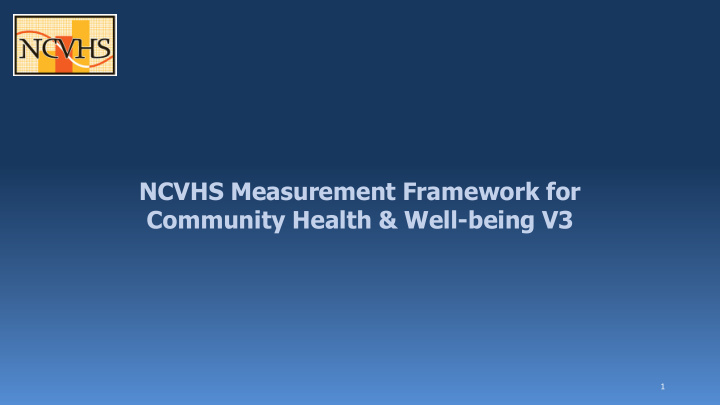



NCVHS Measurement Framework for Community Health & Well-being V3 1
DeKalb County GA Reaction to Measurement Framework V2, as told to Dave Ross, NCVHS Committee Member 2
Purpose of Framework Strengthen multi-sectoral efforts to improve health and well- • being at the local level . Help HHS, other federal agencies and private-sector partners • identify and close gaps in the availability of data at a sub-county level. Offer communities a blueprint of the key issue areas -- domains • and subdomains -- to stimulate and inform dialogue across sectors on barriers, opportunities, and approaches for improvement. Promote public-private collaboration that builds on the successes • of numerous metrics efforts already in development and/or in use. 3
Framework is designed to: Provide a structure for thinking about how to measure • community health and well-being across all determinants Assist in aligning federal data efforts across secretariats • Facilitate community-level data-collection, measurement, and • decision-making Provide a means to use multiple domains to design community • interventions and track their progress Enable assessments through the lenses of equity and life-course • considerations 4
What the Framework is not… • Replacement of other framework efforts. • Comprehensive or prescribed list of indicators. • Ranking or comparison of communities. • Stand on its own – refer to the Roadmap to Community Level Health Measurement for context 5
Environmental Scan: Purpose • To Scan health and non-health sectors to identify existing measurement frameworks, core domains, indicators, and metrics for community health and well-being • To provide a meta-synthesis to guide development of V2 of the Measurement framework • To note examples of indicators or metrics that are available at the sub-county-level and the related data sources 6
Gib Parrish Presentation 7
NCVHS Measurement Framework, V3 Domains Sub-domains Health Health care infrastructure Health behaviors Health conditions & diseases Health outcomes Environment Natural environment Neighborhood characteristics Education Infrastructure & capacity Participation & achievement Economy Income and wealth Employment Food and Agriculture Food availability Nutrition Public Safety Infrastructure Perceptions of public safety Crime Injuries 8
Domains Sub-domains Community Vitality Social capital Governance Civic engagement Social inclusiveness Housing Infrastructure & capacity Quality Use/affordability Transportation Infrastructure & capacity Quality Use/affordability Demographics Total population Affordable Care Act variables: Age Sex Race/ethnicity Primary language Disability Other demographics 9
How this Framework Fits with Others Developed using the environmental scan as foundational reference. Guiding principles used for development: • Similarity with frameworks being used by neighborhood indicator projects • Organized to align with Federal Agencies to promote collaboration • Domain categories are parallel in scope Is not considered a replacement for other framework efforts. Rather, serves as a convening framework to support alignment, federal involvement, and collaboration. 10
Multilevel Model by Kaplan, et al. (2000) FIGURE 2-1 Multilevel approach to epidemiology, 2000. The approach of Kaplan et al. (2000) attempts to bridge various levels of explanation and intervention, bringing together theory and empirical work that link observations of causal influence and mechanism at multiple levels. SOURCE: IOM (2000a).
Influence of Health Status Over the Life Course 12
Who Provided Feedback on the NCVHS Measurement Framework V2 • Non-profits (n=13) • State/local Government and Health Organizations/Providers (n=7) • Academic Institutions (n=3) • Federal Government (n=6) 13
Categories of Feedback and Responses to Each • Domain/subdomain concerns: Added subdomains and example indicators for clarification Elucidated intent to call out various federal departments • Requests for specific indicators: Clarified purpose of Framework and definitions of domains/indicators/metrics • Comments on the relationships between indicators: Explained purpose was not to look at cause and effect • Questions regarding how framework will be used: Reworked introduction to make purpose clearer 14
Framework v1 Framework v2 Framework v3 Changes to Framework over time November 2015 June 2016 September 2016 Outcomes Health Health • Life expectancy • Health outcomes • Health care & infrastructure • Well-being • Health conditions & diseases • Health behaviors Health Behaviors • • Health conditions & diseases Health behaviors • Obesity and relevant behaviors • • Health outcomes Health care & infrastructure • Tobacco Environment Environment • • Natural environment • Natural environment Substance abuse (alcohol/drug) Clinical Care • • Neighborhood characteristics Neighborhood characteristics • Access to care Education Education • Quality of care • Educational participation & attainment • Infrastructure & capacity Physical Environment • • Participation & achievement Educational infrastructure & capacity • Air quality Economy Economy Social and Economic • Income and wealth • Income and wealth • Education • • Employment Employment • Public Safety Food and Agriculture Poverty • • Crime • Food availability Housing • • • Safety Infrastructure Nutrition • Public Safety Perceptions of public safety • • Infrastructure Injuries Social Cohesion and Civic Vitality • Perceptions of public safety • Social cohesion • Crime • • Civic engagement Injuries Housing Community Vitality • Infrastructure/capacity • Social capital • • Availability/affordability Governance • • Quality Civic engagement Transportation • Social inclusiveness • Infrastructure Housing • • Infrastructure & capacity Use • • Quality Quality Demographics • Use/affordability • Age Transportation • Sex • Infrastructure & capacity • • Quality Race/ethnicity • • Use Primary language • Demographics Disability • Total population • ACA demographics • Other demographics 15
Questions to Discuss in Groups What brings you here today? Your interests and/or hopes for this meeting? Thoughts on the Framework? What do you see as the greatest potential value for this evolving Framework? 16
Recommend
More recommend